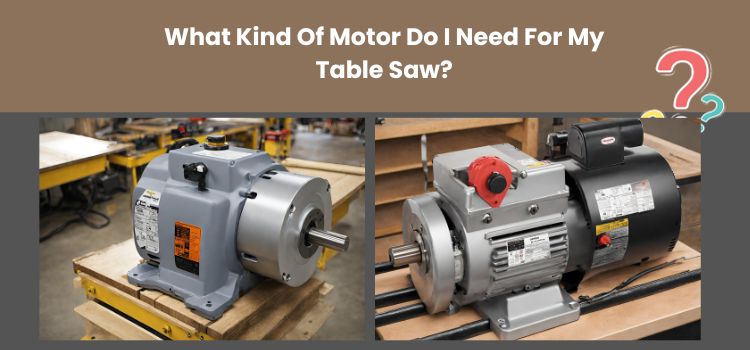What Kind Of Motor Do I Need For My Table Saw? Explained With Example

Choosing the right motor for your table saw is a critical decision affecting the tool’s performance and the quality of your work.
In this post, we will explore the two primary types of motors: direct drive and belt drive, and find out what kind of Motor you need for your Table Saw.
Motor Power and Drive Types in Table Saws
Table saws mainly come in two drive types: direct drive and belt drive. Direct drive motors are directly connected to the blade, offering less power but more portability.
In contrast, belt drive motors use a belt and pulley system, providing more power and less vibration but are bulkier.
Choosing the right type depends on your specific needs, the nature of your projects, and the space available in your workshop.
How Much Power Does a Table Saw Need?
Power in table saws is measured in horsepower (HP). The motor size directly influences the power output.
To determine your power requirements, consider the thickness and hardness of the wood you’ll be cutting and the frequency of use.
Here’s a handy table illustrating power requirements for different horsepower table saws:
- 1-2 HP: Suitable for thin, softwood
- 3-5 HP: Ideal for hardwood and frequent use
Table Saw Motor Types
Revisiting the motor types, direct drive motors are compact, require less maintenance, and are generally cheaper. However, they might struggle with thicker or harder wood.
Belt drive motors, with their increased power and reduced vibration, handle denser materials efficiently but are heavier and may require belt replacements.
Your choice should align with your project needs, budget, and workspace considerations.
What Kind of Motor Do I Need for My Table Saw?
Let’s understand this with a few Scenario for better understanding:
1. Scenario: Lightweight and Portable Projects
Example: A hobbyist working on small-scale, lightweight projects in different locations.
Motor Type: A direct drive motor would be ideal due to its portability and lower cost, as it offers sufficient power for thin, softwood.
2. Scenario: Heavy-duty Workshop Usage
Example: A professional woodworker creating custom hardwood furniture.
Motor Type: A belt drive motor with 3-5 HP would be suitable for handling denser materials, offering more power, and reduced vibration, despite its bulkiness.
3. Scenario: Limited Workshop Space
Example: A DIY enthusiast with a compact working space focusing on varied projects.
Motor Type: A direct drive motor would be advantageous for its compactness, requiring less space, while providing adequate power for general use.
4. Scenario: High Precision and Consistency
Example: A craftsman involved in creating intricate wooden art pieces requiring precision and consistency.
Motor Type: A belt drive motor would be preferable for its reduced vibration and increased power, ensuring precise and consistent cuts on varied materials.
5. Scenario: Budget-conscious Occasional User
Example: A homeowner needs a table saw for occasional DIY projects and home repairs.
Motor Type: A direct drive motor would be an economical choice, providing enough power for less frequent, lighter tasks, and requiring less maintenance.
Conclusion
Selecting the appropriate motor for your table saw is paramount for achieving optimal performance and desired results in your carpentry projects. Assess your needs, consider the pros and cons of each motor type, and evaluate the specifications to make an informed decision.
Whether you’re leaning towards a direct drive for its convenience or a belt drive for its power, ensuring it aligns with your carpentry projects’ demands will lead to a smoother, more efficient woodworking experience.
FAQS:
How many HP do you need in a table saw?
The HP needed in a table saw depends on the material and usage; 1-2 HP is suitable for thin, softwood, while 3-5 HP is ideal for hardwood and frequent use.
How many rpm does a table saw need?
Most table saws operate between 3,000 to 5,000 RPM, depending on the model and the manufacturer; the specific requirement depends on the cutting task and material.
Is higher RPM better for table saw?
Higher RPM can mean faster cuts and efficiency, but it isn’t always better; it might lead to rougher cuts and increased wear on the blade and motor.
What is the best RPM for cutting wood?
The best RPM for cutting wood varies; typically, between 3,000 to 5,000 RPM is sufficient for most woodworking tasks, balancing cut quality and efficiency.
Do you cut wood fast or slow?
The speed of cutting wood depends on the material and desired finish; harder woods and precision cuts generally require slower speeds for optimal results.
How do I choose my cutting speed?
Choose cutting speed based on material hardness, blade type, and desired finish; consult the tool’s manual and experiment on scrap material for optimal results.
How do you calculate cutting RPM?
To calculate cutting RPM, use the formula: RPM = (Cutting Speed x 12) / (Pi x Diameter of the blade), adjusting for material and blade specifications.
